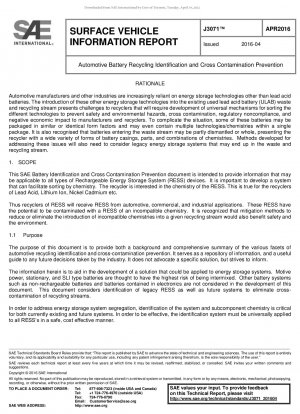SAE J3071-2016
Automotive Battery Recycling Identification and Cross Contamination Prevention
- Standard No.
- SAE J3071-2016
- Release Date
- 2016
- Published By
- SAE - SAE International
- Latest
- SAE J3071-2016
- Scope
- This SAE Battery Identification and Cross Contamination Prevention document is intended to provide information that may be applicable to all types of Rechargeable Energy Storage System (RESS) devices. It is important to develop a system that can facilitate sorting by chemistry. The recycler is interested in the chemistry of the RESS. This is true for the recyclers of Lead Acid@ Lithium Ion@ Nickel Cadmium etc. Thus recyclers of RESS will receive RESS from automotive@ commercial@ and industrial applications. These RESS have the potential to be contaminated with a RESS of an incompatible chemistry. It is recognized that mitigation methods to reduce or eliminate the introduction of incompatible chemistries into a given recycling stream would also benefit safety and the environment. Purpose The purpose of this document is to provide both a background and comprehensive summary of the various facets of automotive recycling identification and cross-contamination prevention. It serves as a repository of information@ and a useful guide to any future decisions taken by the industry. It does not advocate a specific solution@ but strives to inform. The information herein is to aid in the development of a solution that could be applied to energy storage systems. Motive power@ stationary@ and SLI type batteries are thought to have the highest risk of being intermixed. Other battery systems such as non-rechargeable batteries and batteries contained in electronics are not considered in the development of this document. This document considers identification of legacy RESS as well as future systems to eliminate crosscontamination of recycling streams. In order to address energy storage system segregation@ identification of the system and subcomponent chemistry is critical for both currently existing and future systems. In order to be effective@ the identification system must be universally applied to all RESS's in a safe@ costeffective manner. A common approach to chemistry identification is needed and must be agreed upon by the battery manufacturers to reduce the contamination risk during battery recycling operations on a global level. Agreed upon concensus of identification technology and tools must also be applicable throughout the life cycle@ to reduce costs and risk.
SAE J3071-2016 history
- 2016 SAE J3071-2016 Automotive Battery Recycling Identification and Cross Contamination Prevention
